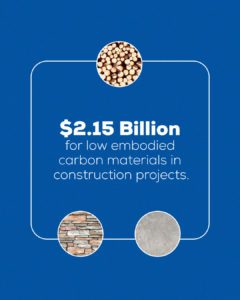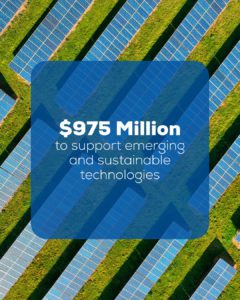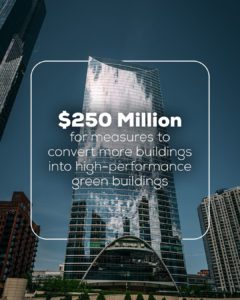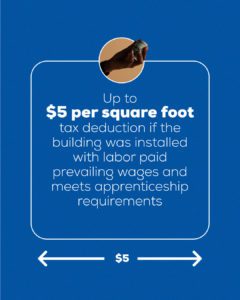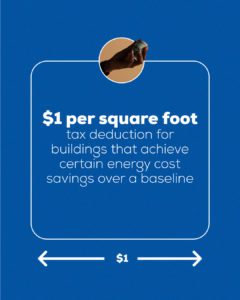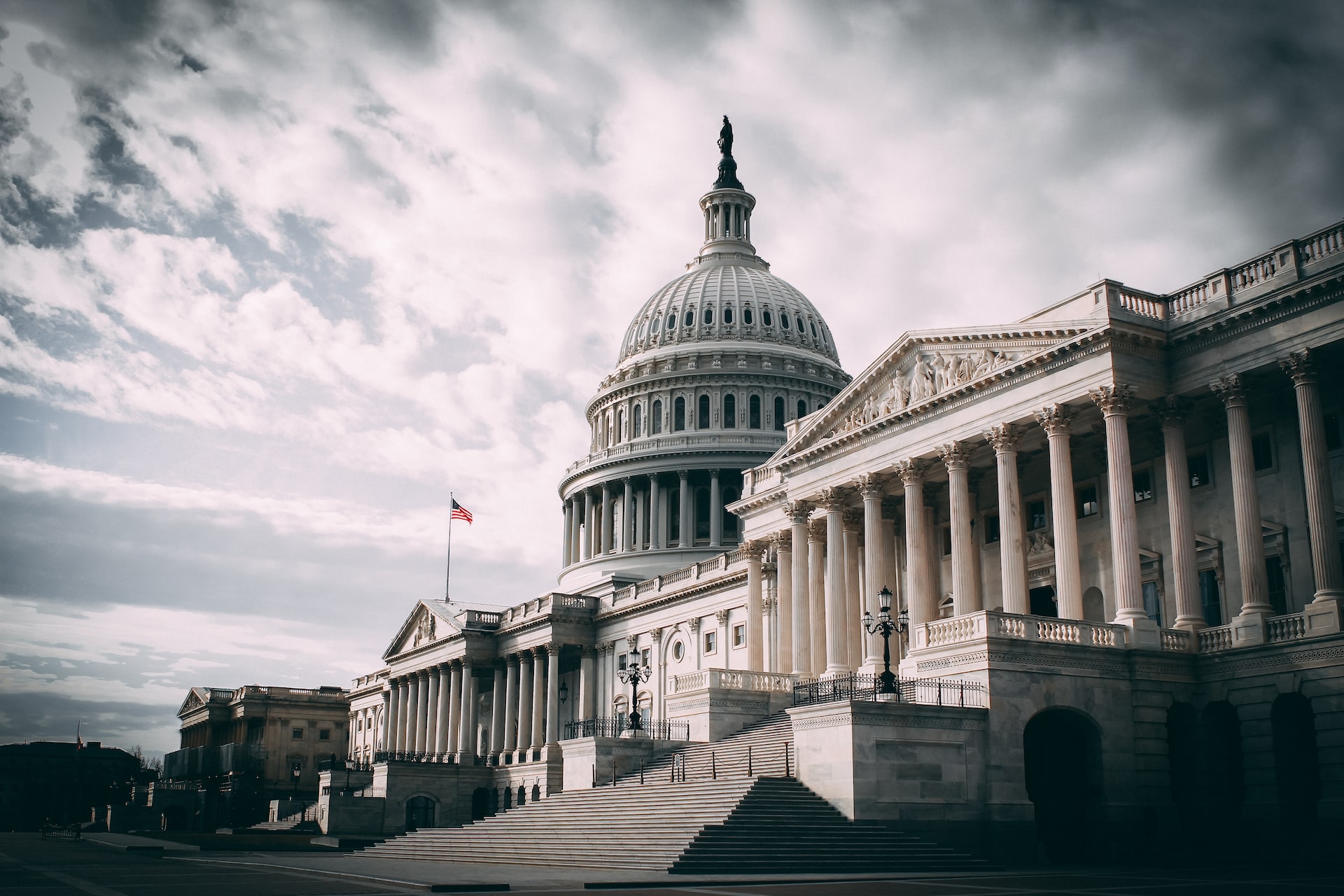
The 2022 Inflation Reduction Act has been passed and provides $369 billion dollars for energy efficiency and climate change to reduce the nation’s carbon footprint. In fact, the new tax code is projected to reduce greenhouse gas emissions by 40% before 2030.
There seems to be something in this bill for everyone: the federal government, business owners, as well as citizens. Whether you are in the market for a new electric car or an HVAC system for a commercial building, there is a benefit in this package to support your efforts.
The Inflation Reduction Act of 2022, also referred to as H.R. 5376, is intended to reduce the deficit and lower inflation while investing in domestic energy production as well as carbon output. It was signed into law on August 16, 2022.
The legislation is expected to raise $737 billion via the new tax structure. This includes a 15% tax on corporations (excluding Subchapter S corporations, regulated investment companies, or real estate investment trusts) that exceed 1 billion over a specified 3-year period. This structure will begin in the year 2023.
The expectation of deficit reduction is more than $300 billion. For our purposes here, we will be focusing on the energy efficiency aspect of the bill and how commercial building owners can benefit. Currently, buildings are responsible for approximately 40% of the energy used in the United States.
Most of the bill’s climate benefits will come from incentivizing major shifts, such as building more wind and solar power. Ultimately, the Inflation Reduction Act will allot billions toward green energy initiatives. That includes a 30% tax credit for building or repairing renewable energy plants, tax credits on green energy generation, and production-related credits for manufacturers of solar and wind power equipment and accessories. H.R. 5376 also includes tax credits for residential solar and battery storage systems, along with other measures aimed at encouraging individuals to cut their carbon emissions.
Moreover, there is nearly $1 billion allocated for converting federal buildings to high-performance green buildings and over $2 billion for the GSA to build or alter their building portfolio with low embodied carbon products.
Key Energy Efficiency Benefits for Government and Commercial Buildings
When it comes to improving building energy efficiency in commercial and government buildings, the Inflation Reduction Act seeks to improve building standards, provide tax incentives, and provide money for emerging technologies that reduce carbon emissions.
1. Improved commercial building standards
The bill provides funding to the Department of Energy for grants to states and local governments to adopt and implement building codes for buildings that meet or exceed the 2021 International Energy Conservation Code (IECC). The IECC addresses energy efficiency from cost to energy usage, as well as the use of natural resources and the impact of energy usage on the environment.
Typically building codes are initiated by state or local laws. Technically, there is no national building energy code in the US. Every three years, the IECC is updated to incorporate new building technologies and practices as they evolve over time. This ensures that commercial buildings and residential homes are currently at levels of efficiency. That’s why The IECC is referred to as a model energy code. It’s intended as a guide to facilitate local and state code changes.
Currently, the IECC serves as the go-to source for states adopting an energy code. Consequently, an ICC code is in use or adopted in all 50 states and beyond. The International Energy Conservation Code sets minimum efficiency standards for new construction for a structure’s walls, floors, ceilings, lighting, windows, and doors, as well as both duct and air leakage.
2. Building Energy Efficiency Tax Incentives
The Inflation Reduction Act calls for reviving a credit that ended last year. As a result, it will be retroactive for all of 2022 and extended for more than a decade. It is intended to equate to approximately 30% of the total cost of replacing the following energy users in a building.
These rebates are as follows:
- Up to $1,600 for insulation, air sealing, and ventilation.
- Up to $1,750 for a heat pump water heater.
- Up to $2,500 for electric wiring.
- Up to $3,000 for solar panel installation
- Up to $4,000 for a breaker box upgrade.
- Up to $8,000 for a heat pump for space heating or cooling.
Once installed, certain appliances like heat pumps are also cheaper to run in the majority of the United States. It is also important to note that electric appliances, unlike fossil fuel-powered ones, can switch to run on renewable energy as more wind and solar power are added to the grid. As a result, participants can expect lower power bills.
Commercial building energy efficiency is also taking precedence. Tax deductions will be available on a per-square-foot basis (up to $1/square foot) for buildings that achieve certain energy cost savings over a baseline. Those tax deductions can be even higher (up to $5/square foot) if the building was installed with labor paid prevailing wages and meet apprenticeship requirements. In these scenarios, carbon neutrality, as well as premier-paying jobs are all prioritized.
3. Investment in Emerging Technologies to Reduce Carbon Emissions
According to the National Law review, the Inflation Reduction Act will also include $975 million for emerging technologies and $250 million to convert federal buildings into high-performance green buildings. This will include such options as heat water pumps, energy-efficient windows, and likely GSA Green Proving Ground finalist 3M™ Solar Window Film. If the rebates and tax incentives aren’t enough to make replacing windows affordable or doable for property owners, then applying window film may be your most feasible option.
Additionally, implementing solar window film may fall under the $5 billion allotted for “low embodied carbon” products. If you are unfamiliar with the term, “low-embodied carbon,” it refers to the carbon produced during the entire lifecycle of the product. From the carbon emissions created to manufacture, transport, and even install that product. Even carbon emissions resulting from the disposal of the product are taken into consideration.
This $5 billion fund for low embodied carbon products also includes $2.15 billion earmarked specifically for GSA buildings. We already know that 3M™ Solar Window Film is considered a lower embodied carbon product than glass replacement. Pending its final approval, it may be the premier choice for federal and commercial buildings alike.
Improve Building Energy Efficiency with H.R. 5376 and Solar Window Film from NGS
Not everyone can afford to replace hundreds of windows in a commercial building. Window film is certainly a more cost-effective solution. However, you may be able to afford to add additional energy-saving options, as a result of implementing window film – especially with the new tax incentives. Certain window film implementation may be approved to the point where that installation would be practically free.
Your CFO will definitely approve this one and you may even see a smile in the process. A return on investment for energy-efficient window film is typically 3 years. With the new tax incentives, you could feasibly cut that time in half. If certain window films are approved by the Green Proving Ground program, when these tax benefits are applied, your ROI could be immediate. Further details will follow upon the completion of the GPG program’s testing.
If you want to know exactly how long it will take any of your buildings to see an ROI, reach out to us today. NGS provides a complimentary building modeling assessment using government-approved software. We apply the shape of your building, orientation, and even your HVAC system. We can estimate to the dollar not just your ROI but your monthly expenses moving forward for energy usage as well.
Our GSA Contract (47ASWA20D00C), 8A partnerships, Edgar-compliant purchase co-operatives, and government contracting vehicles enable eligible government entities to expidite and streamline the procurement process. Click here to learn more.
There is no need for guessing games when it comes to implementing energy efficiency in your buildings. We’ve said it before, the best time to implement necessary changes is when someone else helps pay for them.
The funding may take some time to come to fruition, but you can start preparing to get your share today by watching our webinar regarding our GSA Green Proving Ground finalist emerging technology, 3M™ Sun Control Window Film.
Photo by Harold Mendoza

